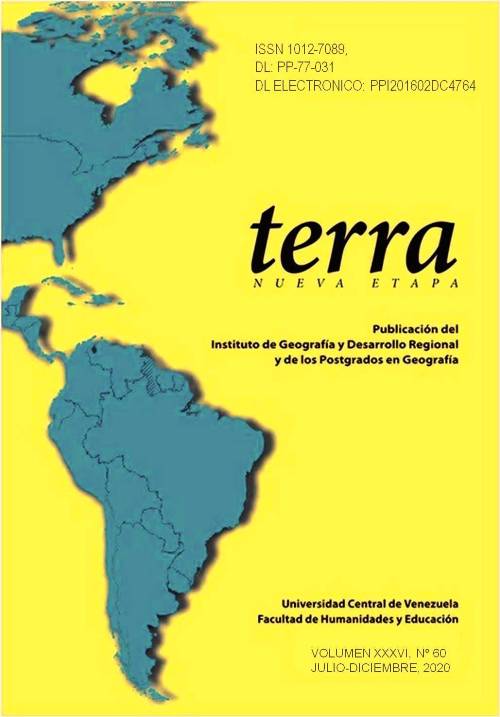Evaluación de áreas con potencial para el establecimiento de sitios de refugio inmediato en caso de un evento sísmico en el municipio Chacao, estado Miranda, 2019.
Palabras clave:
Sitios de refugio inmediato, amenaza sísmica, sismo, población en riesgo, equipos de emergencia, immediate refuge sites, seismic threat, earthquake, population at risk, emergency equipment.Resumen
El municipio Chacao, ubicado en el extremo noroccidental del estado Miranda de Venezuela, se caracteriza por ser
uno de los municipios más desarrollado económicamente del país, además se presenta como una de las zonas con
mayor riesgo sísmico, principalmente, debido a su condición geológica y el espesor de sedimentos que lo caracteriza,
influyendo esto en el movimiento expansivo de las ondas sísmicas al momento de presentarse un fenómeno natural de
este tipo. La creación y acción de planes y propuestas para el resguardo de la población serán fundamentales, debido a
que permitirán la reducción de posibles víctimas al momento de un sismo. En tal sentido, esta investigación tiene como
objetivo evaluar áreas del municipio para el establecimiento de sitios de refugio inmediato a los cuales pueda dirigirse la
población en caso de un evento sísmico para protegerse y ser asistidas por los equipos de emergencia y las instalaciones
críticas. Para dicha finalidad, se toman en cuenta variables como geología, amenaza sísmica, pendiente, la distancias de
los posibles sitios de refugio inmediato tanto a las edificaciones y demás estructuras como a las instalaciones críticas, y la
accesibilidad, las cuales son procesadas mediante el Análisis de Componentes Principales (ACP), obteniendo cuatro (4)
categorías, correspondientes a bajo, moderado a bajo, moderado a alto y alto potencial, obteniendo como resultado que
los sitios de refugio inmediato con mayor potencial se encuentran ubicados al sur y al suroeste del municipio, mientras
que los que poseen un bajo potencial se ubican hacia el noreste del área.
Abstrac
The Chacao municipality, located in the extreme northwest of the Miranda state of Venezuela, is characterized for
being one of the most economically developed municipalities in the country, it also present itself as one of the areas
with the highest seismic risk, mainly due to its geological condition and the thickness of sediments that characterizes
it, influencing this in the expansive movement of seismic waves at the moment of presenting a natural phenomenon
of this type. The creation and action of plans and proposals for the protection of the population will be fundamental,
because they will allow the reduction of possible victims at the time of an earthquake. In this regard, the objective of this
research is to evaluate areas of the municipality for the establishment of immediate refuge sites to which the population
can address in the case of a seismic event to protect themselves and be assisted by emergency equipment and critical
facilities. For this purpose, are taken into account variables such as geology, seismic threat, pending, the distances of
possible immediate refuge sites to buildings and other structures as well as to critical facilities, and accessibility, which
are processed though the Principal Components Analysis (PCA), obtaining four (4) categories corresponding to low,
moderate to low, moderate to high and high potential, obtaining as a result that the immediate refuge sites with the
greatest potential are located to the south and southwest of the municipality, while those with low potential are located
towards the northeast of the area.

